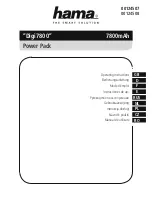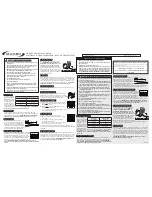
5
2. BATTERY SAFETY RULES
Battery tool use and care
a) Recharge only with the charger specified by the
manufacturer.
A charger that is suitable for one type of
battery pack may create a risk of fire when used with another
battery pack.
b) Use power tools only with specifically designated battery
packs.
Use of any other battery packs may create a risk of
injury and fire.
c) When battery pack is not in use, keep it away from other
metal objects, like paper clips, coins, keys, nails, screws
or other small metal objects, that can make a connection
from one terminal to another.
Shorting the battery terminals
together may cause burns or a fire.
d) Under abusive conditions, liquid may be ejected from
the battery; avoid contact.
If contact accidentally occurs,
flush with water. If liquid contacts eyes, additionally seek
medical help. Liquid ejected from the battery may cause
irritation or burns.
Additional safety instructions
We pay a great deal of attention to the design of every
battery pack to ensure that we supply you with batteries
which feature maximum power density, durability and
safety. The battery cells have a wide range of safety devices.
Each individual cell is initially formatted and its electrical
characteristic curves are recorded. This data is then used
exclusively to be able to assemble the best possible battery
packs.
Despite all the safety precautions, caution must
always be exercised when handling batteries. The following
points must be obeyed at all times to ensure safe use.
Safe use can only be guaranteed if undamaged cells are
used. Incorrect handling can cause cell damage.
Important:
Analyses confirm that incorrect use and poor
care are the main causes of the damage caused by high
performance batteries.
Information about the battery
1. The battery pack supplied with your cordless tool is not
charged. The battery pack has to be charged before you
use the tool for the first time.
2. For optimum battery performance avoid low discharge
cycles. Charge the battery pack frequently.
3. Store the battery pack in a cool place, ideally at 15°C and
charged to at least 40%.
4. Lithium-ion batteries are subject to a natural ageing
process. The battery pack must be replaced at the latest
when its capacity falls to just 80% of its capacity when
new. Weakened cells in an aged battery pack are no
longer capable of meeting the high power requirements
and therefore pose a safety risk.
5. Do not throw battery packs into an open fire. There is a
risk of explosion!
6. Do not ignite the battery pack or expose it to fire.
After Sales Support
EMAIL: [email protected]
TEL: 1300 922 271
7.
Do not exhaustively discharge batteries.
Exhaustive
discharge will damage the battery cells. The most
common cause of exhaustive discharge is lengthy
storage or non-use of partly discharged batteries. Stop
working as soon as the performance of the battery falls
noticeably or the electronic protection system triggers.
Place the battery pack in storage only after it has been
fully charged.
8.
Protect batteries and the tool from overloads.
Overloads
will quickly result in overheating and cell damage inside
the battery housing without this overheating actually
being apparent externally.
9.
Avoid damage and shocks.
Replace batteries which have been dropped from a height
of more than one meter or which have been exposed to
violent shocks without delay, even if the housing of the
battery pack appears to be undamaged. The battery cells
inside the battery may have suffered serious damage.
In this respect, please also read the waste disposal
information.
10. If the battery pack suffers overloading and overheating,
the integrated protective cut-off will switch off the
equipment for safety reasons.
Important.
Do not press the ON/OFF switch any more if
the protective cut-off has actuated. This may damage the
battery pack.
11. Use only original battery packs. The use of other batteries
may result in injuries, explosion and a fire risk.
Information on chargers and the charging process
1. Please check the data marked on the rating plate of the
battery charger. Be sure to connect the battery charger
to a power supply with the voltage marked on the rating
plate. Never connect it to a different mains voltage.
2. Protect the battery charger and its cable from damage
and sharp edges. Have damaged cables repaired without
delay by a qualified electrician.
3. Keep the battery charger, batteries and the cordless tool
out of children’s reach.
4. Do not use damaged battery chargers.
5. Do not use the supplied battery charger to charge other
cordless tools.
6. In heavy use the battery pack will become warm. Allow
the battery pack to cool to room temperature before
commencing with the charging.
7.
Do not over-charge batteries.
Do not exceed the maximum charging times. These
charging times only apply to discharged batteries.
Frequent insertion of a charged or partly charged battery
pack will result in overcharging and cell damage. Do not
leave batteries in the charger for days on end.







































